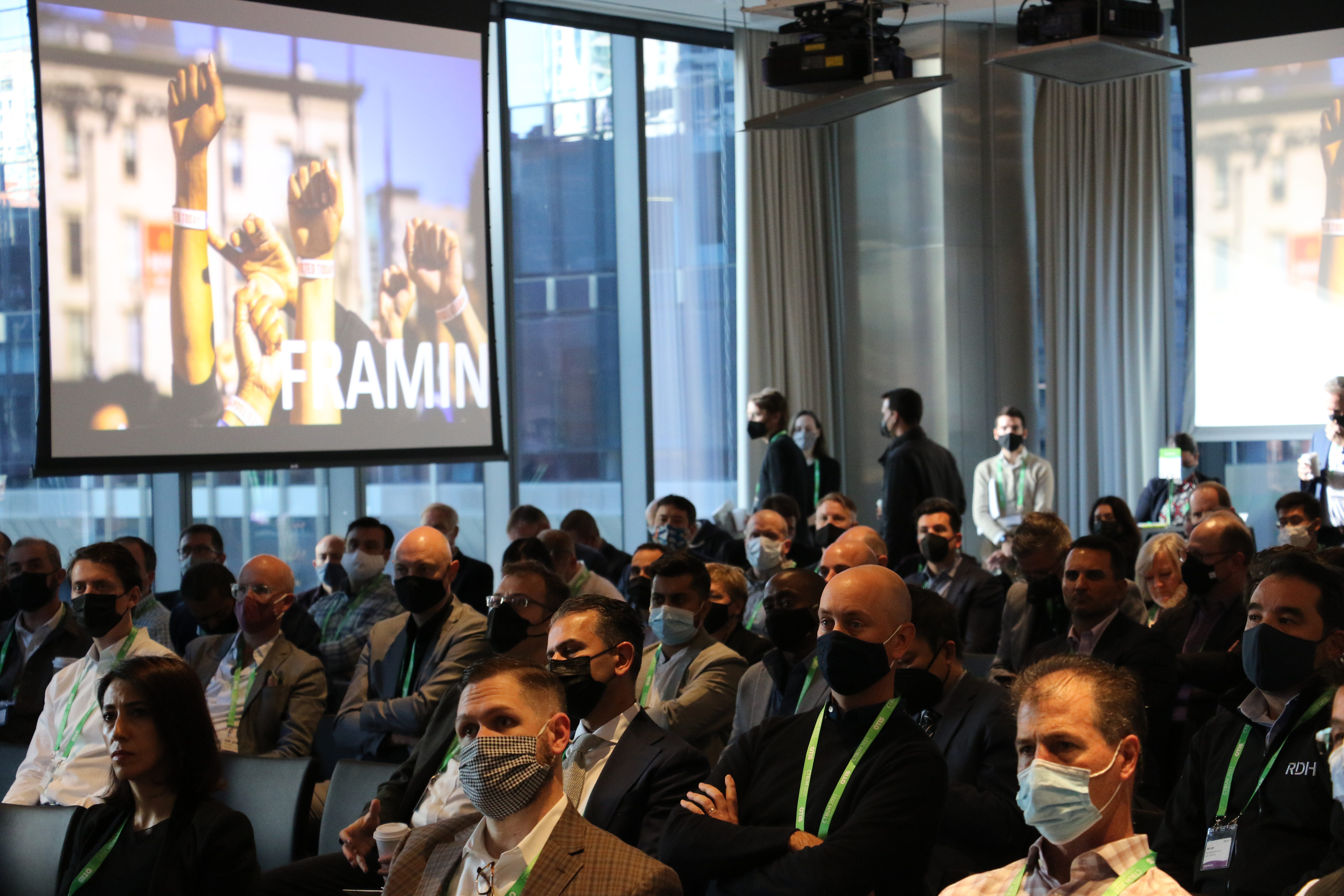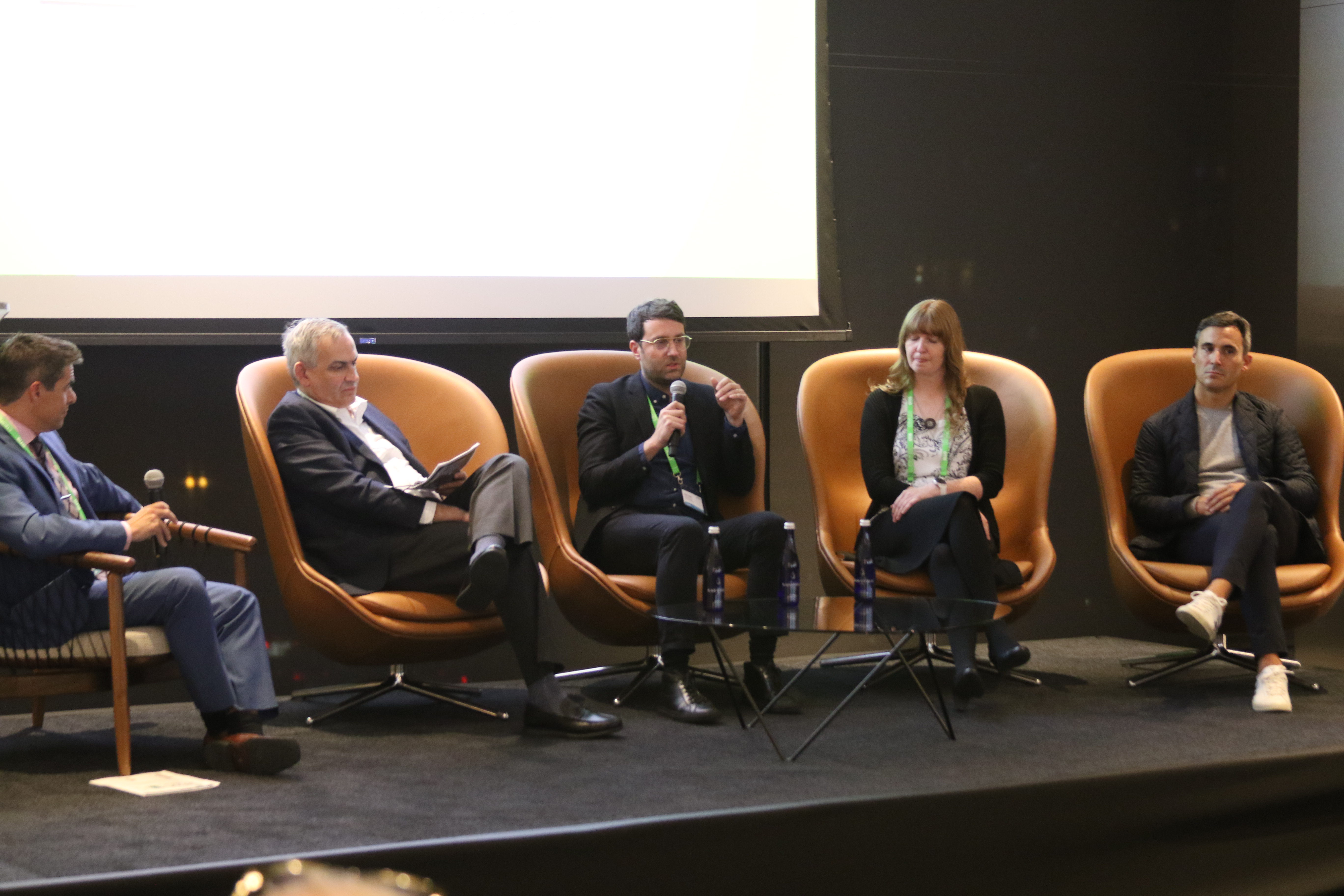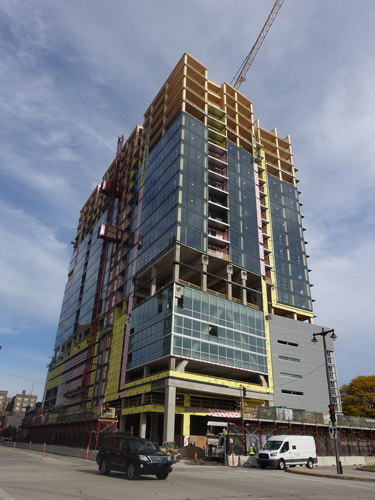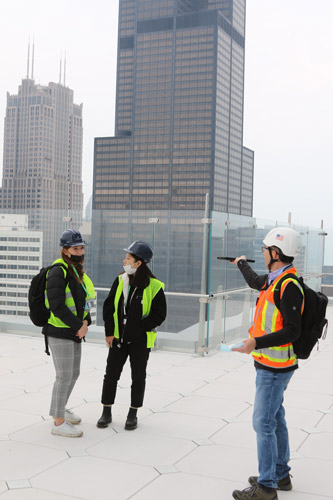Council Takes Stock of Challenges and Opportunities at CTBUH 2021 International Conference Event in Chicago
16 November 2021

The audience was riveted during the opening session of the CTBUH 2021 International Conference event in Chicago in the Forum at 110 North Wacker.
The room buzzing with excitement at reuniting in person for the first time since 2019, the CTBUH 2021 International Conference event in Chicago (one of 19 worldwide) took place in the Forum, the third-floor event space at the newly constructed 110 North Wacker in Chicago, on 8 November. The day’s proceedings were launched with a welcome from Anthony Scacco, chief operating officer of Riverside Investment & Development, the venue’s owner, and CTBUH CEO Antony Wood. The former remarked on the central role buildings play in safeguarding the well-being of occupants. “Many of us in the investment, design, and construction space have sought new innovations to help our projects be better stewards of their environment, Scacco said. “But one thing that's become much clearer as a function of the Coronavirus pandemic, is the critical role that buildings play and stewarding the daily lives of their occupants.”
During his keynote address, City of Chicago Commissioner of the Department of Planning and Development, Maurice Cox, took up the thread of the responsibilities of the built environment, who discussed the impact of public policy on urban habitats and entrenchment of inequity. “We see a direct connection between the inequity that has been perpetuated over the years, and our ability to be resilient,” Cox said. He discussed the city’s core principles in regard to planning, equity, and resilience, the metrics being used to start measuring progress, and key development programs from the city.
The conference then separated into two tracks, with the core track covering four topical areas: counting, curtailing, and capturing carbon; wellness and equity in cities; the elevator industry’s view on the post-pandemic building; and the future city. The timber track’s four topical areas were the government, code and supply side; the owner-developer's perspective on mass timber in the high-rise realm; engineering challenges and successes; and design and logistical challenges.
Core Track Session Highlights
Moderated by Don Davies, president of Magnusson Klemencic Associates, the first session covered the opportunities and challenges faced in meeting carbon goals in the AEC industry. One place to begin is reducing waste in construction, where more than 30 percent of materials on a project are wasted. Cutting out waste in energy generation and driving energy efficiency further are other key areas, said Nora Wang Esram, senior director for research at the American Council for an Energy Efficient Economy. Only 14 percent of energy extracted from the environment is used to generate useful work, with most of it going to waste. “We need to optimize performance and improve energy productivity,” she said. Representing the materials side of the conversation, Dave Miracle, director of sustainability at Nucor, and Stanley Yee, façade design and construction scientist at Dow, discussed how their companies were reducing the embodied carbon in products. Freya Burton, chief sustainability officer with LanzaTech, discussed using gas fermentation to reuse waste products.

Jaron Lubin, Partner, Safdie Architects, answers an audience question during a panel discussion on "the future city." Also pictured, from left: Antony Wood, CTBUH Chief Executive Officer; Rafael Carreira, Executive Vice President, Riverside Investment & Development; Anke Beyer-Lout, Associate Principal, CPP Wind Engineering Consultants; Scott Duncan, Partner, Skidmore, Owings & Merrill.
In an energized panel discussion, Shelley Finnigan, global technical sales engineer, head of technical sales and marketing, ArcelorMittal, led a conversation on pursuing wellness and equity in cities. Melissa Burton, Canada consulting practice leader, principal, fellow, at Arup, brought up that resilience is tied into vulnerability, not just the hazard itself. This can be the vulnerability of the asset, or of the community, and how a design approach beyond code is necessary. Andre Brumfield, principal – global director of cities+urban design at Gensler, picked up the thread of a wider impact and asked how to create equitable investment and development, and bring the diversity and density of mixed-uses out from the urban core into the neighborhoods.
“Equity in the built environment must be intentional,” said Danielle Tillman, managing principal, bKL Architecture, adding that tall buildings are particularly situated to foster equity since they can house multiple programs, which can drive access and interaction. However, equity has to start within the AEC industry itself. “How can we create equitable spaces if our industry is made up of sameness?” she asked. Kris Lucius, principal, landscape, at SmithGroup, brought up the importance of spreading out access to feature amenity outdoor space as a matter of equitable access but also to diffuse the gentrifying effect isolated projects can have on neighborhoods.
How can we create equitable spaces
if our industry is made up of sameness?
Danielle Tillman, managing principal, bKL Architecture
The elevator industry gathered to discuss how the pandemic is impacting vertical transportation now and into the future. One interesting fact is that elevators have been making essentially the same number of trips during the pandemic as before, just at 40 percent loading. Also, as the work-from-home population levels off at around 30 percent of the workforce, elevators in residential buildings are seeing a steep increase in cycles, which has an impact on maintenance requirements. While the pandemic has driven the acceleration of existing technologies in smart connected buildings, such as through the use of personal credentials for elevator control, a true seamless door-to-door user experience is possible but not yet realized in the market.
The final session of the day in the core track brought a big-picture conversation looking to what the future will hold for cities. CTBUH CEO Antony Wood discussed the stacked impacts of climate change on cities, noting that “the biggest impact on sustainability is location.” The vertical realm will need to contend with increased focus on ventilation in the aftermath of the pandemic, as well as how to attract and retain occupants back to their offices. Instead of benchmarking against a competitor building, Rafael Carreira, executive vice president, Riverside Investment & Development, says building owners are now comparing their buildings against the attraction of staying at home. Scott Duncan, partner, Skidmore, Owings & Merrill, asked provocative questions around the ripple effects of the digitalization of work, which include decoupling business from the urban core. He also wondered, with more people spending more time in virtual worlds, what the role of architects might be in that experience. With a bit of levity putting on a persona of a depressed architect, Jaron Lubin, partner, Safdie Architects, expressed regret that the needle hadn’t yet moved further on adaptive and sustainable vertical environments, yet expressed hope for the future. “It's not just a singular individual's responsibility to solve these problems,” he said. “But perhaps, if we were to come together as a profession of thinkers and architects and urban designers, academics and developers and owners, we could maybe conceive of a new framework.
Tall Timber Track Record Established in Chicago
The Tall Timber Track room was consistently full, at some points standing room only, proving the enduring interest in the topic.

Shaina Doar, President and COO - Mass Timbers Buildings Factory, Sidewalk Labs, answers an audience question during a panel discussion on the owner's perspective on mass timber in the high-rise realm. Also pictured, from left: Tim Gokhman, Managing Director, New Land Enterprises; Lisa Podesto, Senior Business Development Manager, Design Build Americas, Lendlease; Ben Kaiser, Owner and Principal, Kaiser + Path.
Among the highlights, Brian Brashaw, assistant director, wood innovations for the USDA Forest Service brought the unique perspective of being both a forester and a wood products engineer, and was therefore able to describe the input and outputs of the tall timber supply equation. Particularly poignant was the connection between controlling wildfires and other disasters and the well-being of human settlements, as well as the forests themselves. In addition, Brashaw made clear that land conversion and wildfires, not harvesting, were the main drivers of deforestation.
In a presentation devoted to the major changes in the International Building Code (IBC) 2021 edition, Jennifer Cover, president and CEO, WoodWorks, shared that her organization counts 1,232 mass timber projects in North America, with 567 built and 665 still under design. The CTBUH threshold for considering mass timber in high-rises is seven stories, which vastly reduces this number; however, some 122 projects in this cohort exceed the prior 2015 IBC in one or more aspects. This paved the way for WoodWorks to assist many of the developers of these buildings in implementing 2021 IBC-compliant projects, Cover said. Critical to the development of the 2021 IBC code were fire tests that went well beyond typical practices, including loading dwelling units with furniture and assuming no fire sprinklers or fire service intervention. The furniture was consumed, but the fire was contained to the unit; the cross-laminated timber (CLT) used in the tests self-extinguished and did not fail. All of this was undertaken to drive confidence in the mass timber typology going forward.
Optimists adapt to exist. Our adaptation is to move
from concrete and steel to mass timber.
Ben Kaiser, owner and principal, Kaiser + Path
In a much-anticipated panel discussion, four developers of mass-timber tall buildings convened to compare notes. Ben Kaiser, owner and principal of Kaiser + Path, a develop-design-build firm responsible for the Carbon12 project in Portland, Oregon, characterized his own and his peers’ work as an act of optimism and an evolutionary adaptation to a changing world: “Optimists adapt to exist. Our adaptation is to move from concrete and steel to mass timber.”
The panel had unique representation from the software and prefabrication industries, by way of Shaina Doar, president and CEO of mass-timber off-site construction at Sidewalk Labs. The company is developing a mass-timber prefabrication system to address the dire need for new, affordable housing. “We see a real demand for these mid-rise buildings across North America,” Doar said. “I think that there's a sweet spot to be doing these buildings in timber, because that's where a lot of the new construction will happen.”
Lisa Podesto, senior business development manager, design build Americas, Lendlease, relayed her company’s experience developing affordable residential high-rises in the highly regulated and costly Bay Area, reminding attendees that solving the mass-timber production system was only one part of the equation, though it was helpful to solving the rest. “It's not just about figuring the mass timber system out,” Podesto said. “It's also about figuring out the subsequent systems that go with it.”
During the engineering session, Ethan Martin, director of sustainability and mass timber, DCI Engineers, shed light on a common area of confusion when sourcing timber: the difference between certified and managed forests. “Certification is actually a for-profit business, which is prescriptive against clear-cutting,” Martin said. But managed forests, including those maintained by the USDA Forest Service, which use thinning practices to reduce combustible tree cover, are not certified, which makes sourcing from managed forests complicated if there is a mandate to use Forest Stewardship Council (FSC)-certified wood. He noted that other programs, such as the Sustainable Forestry Initiative (SFI) use performance-based standards that do account for thinning and other managed forestry actions.
Through the course of the day, it was clear that there are significant cost advantages that can go some ways toward off-setting the premium placed on a less-familiar building product. Jason Korb, principal architect, Korb + Associates Architects, relayed that Ascent, a 25-story residential building in Milwaukee, whose top 16 floors are constructed in mass timber, requires 50 percent less concrete in its pile system than comparable all-steel or all-concrete buildings. Likewise, there is a human benefit to adopting the unfamiliar. As Chris Johansen, project manager at C.D. Smith Construction, Ascent’s contractor noted, the construction workers appreciate working with mass timber as compared to concrete. “They go home clean and their backs don't hurt," he said.

The first day of the conference in Chicago wrapped up with a networking reception on the 55th floor of 110 North Wacker.
Offsite Tours
The second day of the Chicago event on 9 November featured three offsite tours.



A diverse range of tours on the second day of the conference allowed delegates to engage with the conference themes in person. Pictured from the left: Ascent in Milwaukee, learning about wellness strategies on a rooftop terrace at 320 S. Canal, and participants gathering at The Hatchery.
During a visit to Ascent in Milwaukee, 145 kilometers to the north of Chicago, a select group of 30 attendees toured the under-construction 25-floor residential development that is on track to become the next tallest timber-concrete hybrid in the world, upon completion in August 2022. The project, developed by New Land Enterprises, features 16 floors of cross-laminated timber (CLT) columns, beams, and panels above a 9-story concrete podium and parking structure.
In downtown Chicago, the "Modern Design to Address Health & Wellness from the Ground Up" tour began at 320 S. Canal, covering initial measures designed for the 1.5M square foot office high-rise adjacent to Union Station to improve indoor air quality before and during the COVID pandemic. Later, at the CME Center Lobby Repositioning Project at 10-30 S. Wacker, participants explored the repositioning of an aged lobby typology into a flexible, adaptable, and vibrant open urban living room.
The "INVEST South/West and the Neighborhood Opportunity Fund" tour took place at The Hatchery on the city's west side, and covered work being done to develop commercial corridors in 10 key under-invested Chicago neighborhoods. Presentations from The Hatchery, the Chicago Department of Planning and Development’s INVEST South/West initiative, and the city’s Neighborhood Opportunity Fund (NOF) program were brought to life through on-site visits to an INVEST South/West site and an NOF project.
The Council would like to thank all the sponsors of the
2021 CTBUH International Conference for their support.
Get the Latest News and Updates from CTBUH
Fields with an asterisk (*) next to them are required.
View our privacy policy
